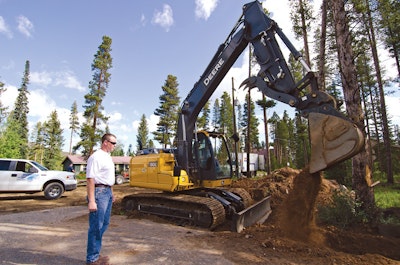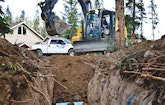
Interested in Industrial?
Get Industrial articles, news and videos right in your inbox! Sign up now.
Industrial + Get AlertsTo understand why Snowbridge Inc. provides so many services – septic tank pumping; septic system installations; repairs and inspections; grease trap cleaning; residential and commercial drain cleaning; and trenchless pipe repair – consider the company’s location in Breckenridge, a ski-resort community nestled in the Rocky Mountains about 80 miles west of Denver.
Breckenridge is a remote community with a small year-round population that swells only when tourists arrive during the skiing season. As a result, Snowbridge, also a Roto-Rooter franchisee, must go farther afield for business, catering to customers as far as 75 miles away, and offer them a multitude of services to sustain business volume and avoid having expensive equipment sit idle.
“We don’t have a lot of any one kind of work to do, so to stay busy year-round, we have to offer a lot of different services,” says Bill Tatro, who co-owns the business with his brother, Chris. “We couldn’t survive just pumping septic tanks or doing inspections. Sometimes it feels like we do way too many things, and other times it feels like we don’t do enough.”
Do it all
Offering diverse services provides other benefits, too, says Tatro. First of all, customers prefer a company that provides opportunities for one-stop shopping. Secondly, it gives the company better control over scheduling because crews don’t have to wait for, say, a tardy excavation subcontractor to arrive for a septic-system installation. And thirdly, it creates independent revenue streams that can help offset slow times in other service segments, not to mention minimizes giving away work to subcontractors.
“We like to be the only company a customer needs to call,” Tatro says. “What starts off as a drainline problem might turn out to be a broken sewer pipe, which we can fix for the customer and keep that revenue in-house … some of our best jobs come from service calls. Many times, service diversity keeps your customers from looking around and hiring somebody else because you can do the job and do it fast.
“Before we started doing our own repair work, we’d refer the work to someone else,” he adds. “We might go out and do a $300 or $400 job and give away $5,000 to a subcontractor. So adding services such as excavation and sewer repairs [pipe bursting and relining] has definitely added revenue streams to our business in the last seven or eight years.”
Septic-pumping roots
Tatro’s entrepreneurial father, Bill Jr., a former dump-truck driver, and his mother, Cheryl, started the business in 1976 after a local operator retired. To fill the void, they bought a vacuum truck and started pumping septic tanks.
Back then, the company also rented and serviced portable restrooms, says Tatro, who started working for his parents when he was 12, washing and repairing restrooms, then eventually doing deliveries and pickups, too. When Tatro turned 17, he started broadening his experience, doing everything from septic pumping runs to sewer and drain cleaning. He’s been a full-time employee for the last 10 years, and he and his brother bought the business in 2009. Bill is president of the company; Chris serves as vice-president.
The company’s roster of equipment has grown considerably over the years. It now includes a 1992 Mack truck (nicknamed “Maxine”) with a 3,000-gallon steel tank made by Cusco Fabricators Inc. (a Wastequip company) and equipped with a 400 cfm Masport pump, a full-opening rear hydraulic door and a vibrator unit. “That’s for removing sand waste from car-wash pits,” Tatro notes.
Snowbridge also relies on a 2000 International 4900 (nicknamed “Rosie”), equipped with a 2,000-gallon steel tank and a 400 cfm Jurop pump. Tatro says that owning one smaller truck was a necessity because many remote customers are accessible only via narrow roads and entry points.
“A lot of the driveways here are just goat trails,” he says. “The terrain is very steep. And after we get 30 inches of snow, the roads get even narrower. Rosie is great because she’s a little more nimble than Maxine.”
High-elevation challenges
The high altitude creates operational challenges, too. Driving to septic customers is difficult in winter, when roads through mountain passes are treacherous. Moreover, the thin air robs some power from things like truck engines and pumps.
“In general, everything we use has to be a little bit bigger and possess a little bit more horsepower than what you’d run at lower elevations,” Tatro says. “Diesel engines must be turbocharged or they don’t work well.”
A vacuum-truck blower that pulls 27 inches Hg at sea level pulls only about 16 or 17 inches at high elevations, and a traditional vane pump generates about 30 to 40 percent less vacuum power, explains Chris Tatro. “You have to keep in mind that sometimes we’re up at 12,000 feet, pumping grease traps and septic systems at resorts, as well as pumping outhouses for ski resorts and the U.S. Forest Service,” he says. “At times, we may have to use 90 feet of hose, which makes it even tougher. Or a tank we’re pumping out might be located 30 or 40 feet below the truck.”
To counteract the reduction in vacuum power created by longer, uphill hose runs, crews use a pressure-lift device called the Power Booster, made by Pressure Lift Corp. Typically placed between the first and second sections of hose, it acts like an air pump, generally adding supplemental vacuum power of about 20 cfm at 90 psi, Chris says.
To clean drainlines, the company also owns a US Jetting 4025 water jetter. It sits inside a heated and insulated 14-foot box body, made by Supreme Corp. and mounted on a 2007 Sterling Acterra chassis. The truck also carries a 600-gallon water tank and the jetter produces pressure of 4,000 psi at 25 gpm.
Tools of the trade
In addition, the truck also carries three RIDGID pipeline-inspection push cameras and two small cable drain cleaning machines from Roto-Rooter. Technicians use jetting nozzles made by Shamrock Pipe Tools Inc. and Warthog nozzles from StoneAge Inc. The company also owns a lateral pipe relining system made by LMK Technologies and a lateral pipe-bursting machine made by Pipe Genie Manufacturing. Snowbridge also uses probes and tools from T & T Tools Inc.
Both vacuum trucks carry jetters (with pumps from Giant Industries and Cat Pumps) and have 200-gallon and 300-gallon water compartments integrated in the tanks. “The jetters come in handy because sometimes [drainfield] lines are back-pitched or the tee is clogged, or we open the clean-out and the line is holding water,” Tatro explains. “We charge an additional fee to clean the line … the jetters are great because it’s better for us to do it right away, rather than have to make a second trip.”
Snowbridge septic crews also use the onboard jetters to clean dosing tanks. Tatro says most septic systems in the company’s home area of Summit County feature three-compartment systems. When crews pump out tanks, they wash out the dosing compartment and effluent filters to keep the third compartment as clean as possible.
The company also owns two Crust Busters, made by Schmitz Brothers LLC – one for each pump truck. “Without them, I think most of our staff would quit,” says Chris Tatro. “We use them for almost everything we pump, from septic tanks to grease traps to car-wash bays. Sand is a very hard material to pump anyway, so if we can work it into a slurry, it’s a lot easier to move it. The Crust Busters probably save us a half hour per job, which really adds up over time.”
Septic business on the wane
Going forward, Snowbridge faces a significant challenge: dwindling numbers of septic systems as more and more homeowners switch to rapidly expanding sewer systems.
“In the meantime, it’s a positive for us because customers are taking better care of their systems to avoid the expense of switching over to sewers,” Bill Tatro points out. “But eventually those systems will fail. And the price of putting in a new septic system here is about $30,000 because of the very tough [excavating] conditions. They’re called the Rocky Mountains for a reason.
“Eventually, there won’t be enough septic customers to support the industry here … some people are going to go out of business,” he adds.
But by pushing hard for diversification – coupled with the company’s good reputation and longevity in the community – the Tatro brothers are doing their best to ensure that Snowbridge won’t be one of those companies.
“We’ve really tried to diversify so that when certain revenue streams get smaller, others get bigger,” Bill says. “Slowly, most of the septic systems in this county will go away, except in outlying areas. But our strategy is to diversify again, this time into trenchless pipe repair and sewer-line installations.”









